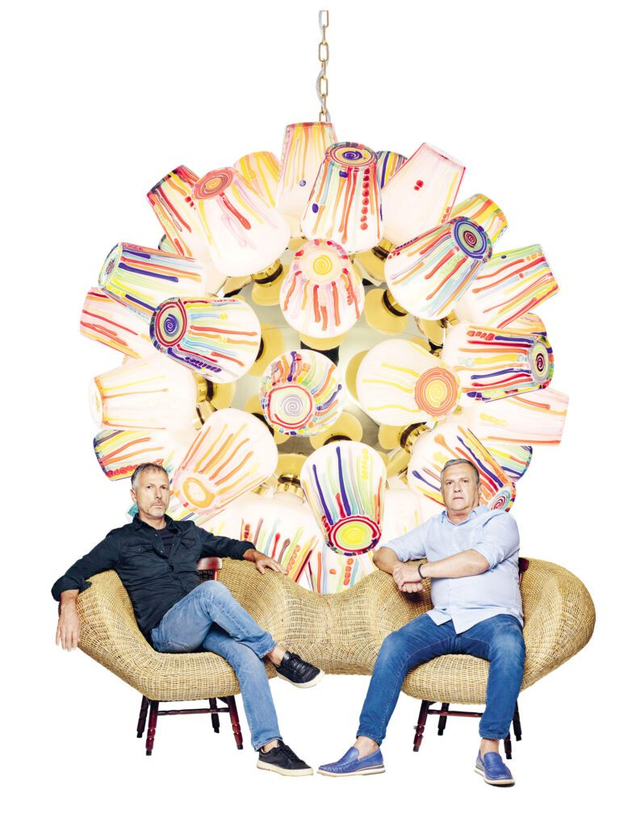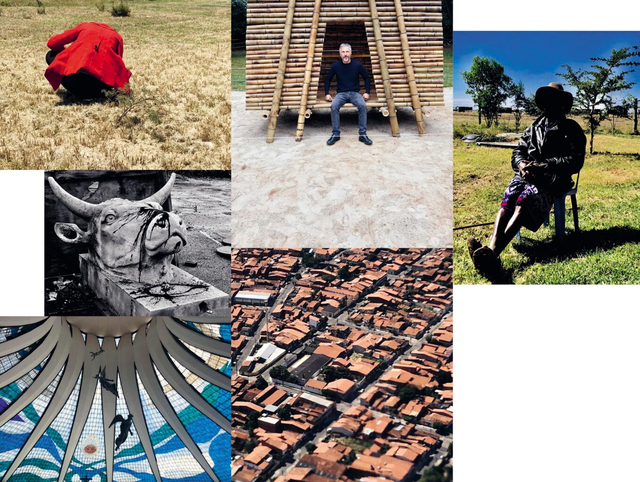Getting to Know The Campanas
By: Stephan Hamel
Photo: Humberto and Fernando Campana
My first acquaintance with the Campana brothers took place in the late 1990s. At the time, I was in close contact with Massimo Morozzi, founder of Archizoom and a great master of proportions. It was in 1997 that he mentioned he had seen something special done by two young Brazilian designers. I began to look in the Sao Paulo phonebook and found eight different phone numbers for Campana. The third one was correct and with Fernando Campana on the line, it was like winning the lottery. The brothers came to Italy to develop the prototypes of a later icon, known as the Vermelha chair. We had a great time from the first moment.
Massimo Morozzi was like a father to them. He introduced the Campanas to the design scene without the pretense of making them a star. Massimo was simple, humble and essential and he was able to adjust their Brazilian baroque attitude as needed. The result was some extraordinary pieces that found their immediate way into the most important collections. The very first was the Museum of Modern Art in 1998. After the presentation in Milan at the fair in April, Paola Antonelli herself decided to invite them for a show at the MoMA in New York in November, together with Ingo Maurer. It was a dream coming true!
The streets of Sao Paulo like Avenida 25 Mayo, with all their small shops and thousands of street vendors were part of the Campana’s inspiration. Humberto’s and Fernando’s father was an agronomist and they always related to plants and organically structured surfaces. Humberto had always been more moderated and Fernando more extreme. I remember visiting favelas with Fernando and his authentically direct communication with people. On the other hand, Humberto collects information with immense patience and makes it visible. In their procedure, you find the same multiethnic mixture inspired by Brazilian as well as Italian music, thanks to their partly Italian origin.
Brotas, the city they come from, is a nearly Italian city, with families from Ferrara, Lucca and Rovigo. It is like stepping into a neorealist film, where nobody speaks Italian, but behaves Italian. This small city had a cinema where Italian films where performed. While in Italy, Teorema by Pierpaolo Pasolini was prohibited, but they saw it at a young age more than ten times. This is extremely fascinating, because a strong sense of poetry and critical vision was also given by their nanny Alice, who is an angel for them. The Campana method of operation is always through sensitive research that is nearly as esoteric as Brazil itself.
It is great to have seen the Campanas grow over the years, especially because Humberto originally wanted to become an Indios, since he studied law, but he realized that it was not his skill. Fernando was certain about his career as an astronaut, but studied architecture and began to work at the Modern Art Museum in Sao Paolo. When they were kids, Oscar Niemeyer was building Brasília, the capital. Once they grew up, they met him for an interview and he asked them what they really wanted to do. The Campanas wanted to reflect their world. Spread the message of being what they are: Brazilian. Through them I learned the important message of being regional better than global, which through the art director Maxim Velčovský infiltrated Lasvit with great success.
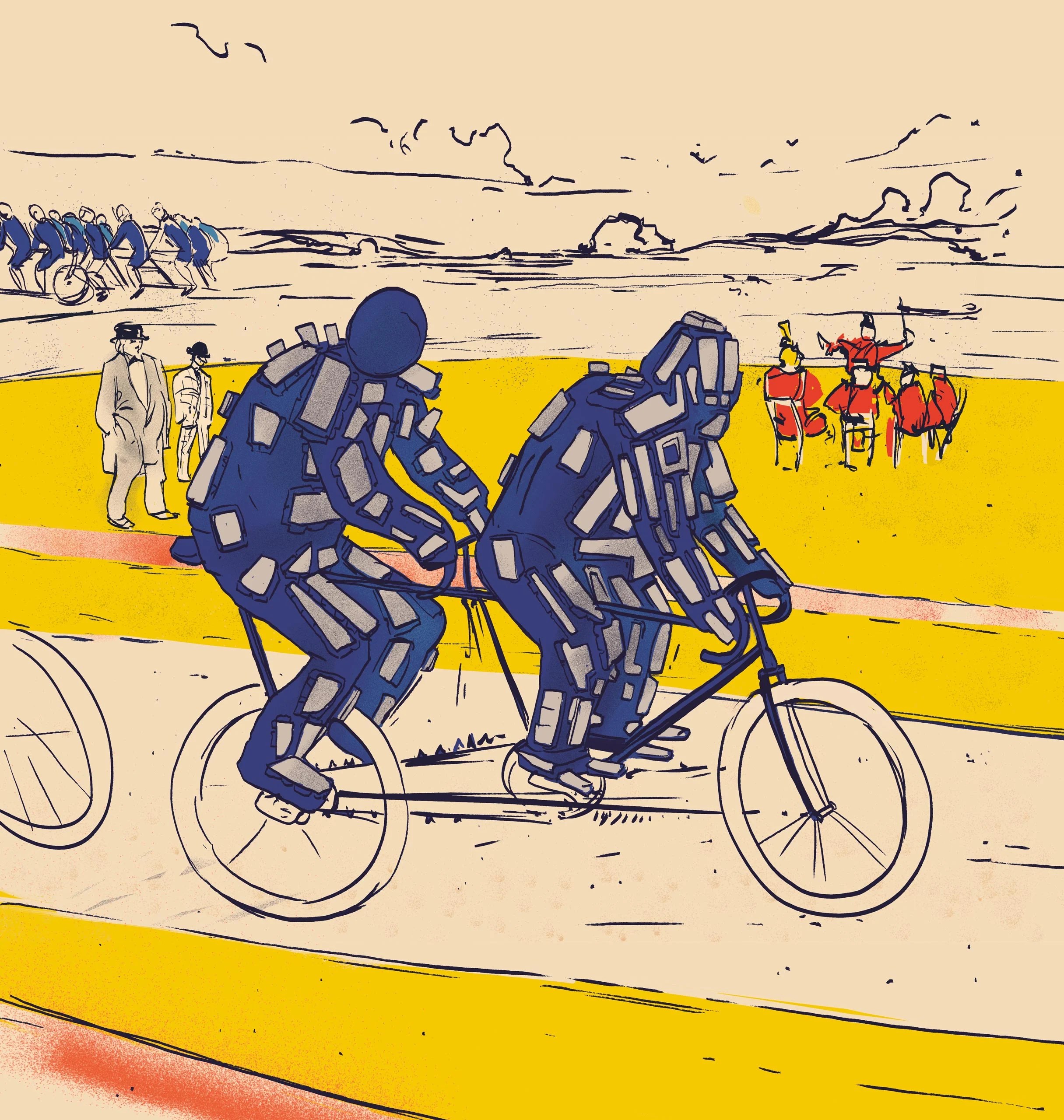
“Like aliens with human shape, Flix and Flex originally came down from space and their surface is their skin. Unlike astronauts, they don‘t have a protective layer between themselves and the outside enviroment. The Outer Space Monsters might be everywhere – sometimes we are not sure if they are real or just hallucinations.” Thus the designers describe the nature of their Flix and Flex statuettes from the Monsters Collection for Lasvit from 2018.
My dear Campanas, tell me, what was your original motivation to start with design and what is it now? Which role should design play in today’s society?
Fernando Campana: I think the first lightning bolt in my life was when my parents moved to Brasilia. It was a dream. I studied architecture in Sao Paolo and I also had an internship at the 17th biennale of Sao Paolo, which gave me a balance of both art and practice. Today I can see the importance of the 70s and 80s in my life, it stimulated my imagination and brought me to design. At the same time, I learned a lot about planning a project. Design today is going further because we have a lot of environmental and social issues, mainly here in Brazil and design can be a tool to transform people, their homes and lives…
Fernando Campana: I think the first lightning bolt in my life was when my parents moved to Brasilia. It was a dream. I studied architecture in Sao Paolo and I also had an internship at the 17th biennale of Sao Paolo, which gave me a balance of both art and practice. Today I can see the importance of the 70s and 80s in my life, it stimulated my imagination and brought me to design. At the same time, I learned a lot about planning a project. Design today is going further because we have a lot of environmental and social issues, mainly here in Brazil and design can be a tool to transform people, their homes and lives…
Fernando, you and Humberto started in the 80s, in 1998 you had an international breakthrough. But already at the very beginning you began looking at social aspects coming out of the Brazilian society. Can you elaborate more on that?
Fernando: It happened by chance. We didn’t have the guts to go to a big company and present our projects based on handicraft. Instead, we began contacting small producers – craftsmen who taught us the basics of production techniques. Here in Brazil we have a long tradition of handicraft coming from the indigenous people and the Portuguese. The turning point was when Italians came to Brazil in the 19th century. It was a real revolution, not only in terms of manufacturing, but also in art. In Brazil and Africa there is an increasing need to embrace the tradition of handicraft, which is slowly disappearing. In Europe you already had the boom of mass-produced furniture and now you are coming back to more conscious production. In Brazil, the industry is expanding these days and people are forgetting the handicrafts. Without being immodest, me and Humberto are some of the few who want to save it.
Humberto, your projects often work with very local topics related to a specific social issue. How can you transform these topics into an aesthetic object attracting global attention?
Humberto: I travel a lot and I try to create stories and images of the places that I visit, including the emotions I feel. An artist should have the potential to see what passersby cannot see. Our main challenge with Fernando is to transform those banalities into new dialogues. I like this process of transforming something rather ordinary at first sight. And to re-signify – give a new meaning to already existing things, professions, techniques. Since the beginning, Fernando and I have been used to changing the DNA of something very poor and transforming it into rich and opulent objects.
Fernando: It is a kind of partnership. We want to create a bridge between the Instituto/Studio Campana and small communities or single craftsmen. We have a partial aesthetic intrusion into the project and we let them teach us how to adopt a different technology, a low-tech approach in our aesthetic. I think this is a two-way street.
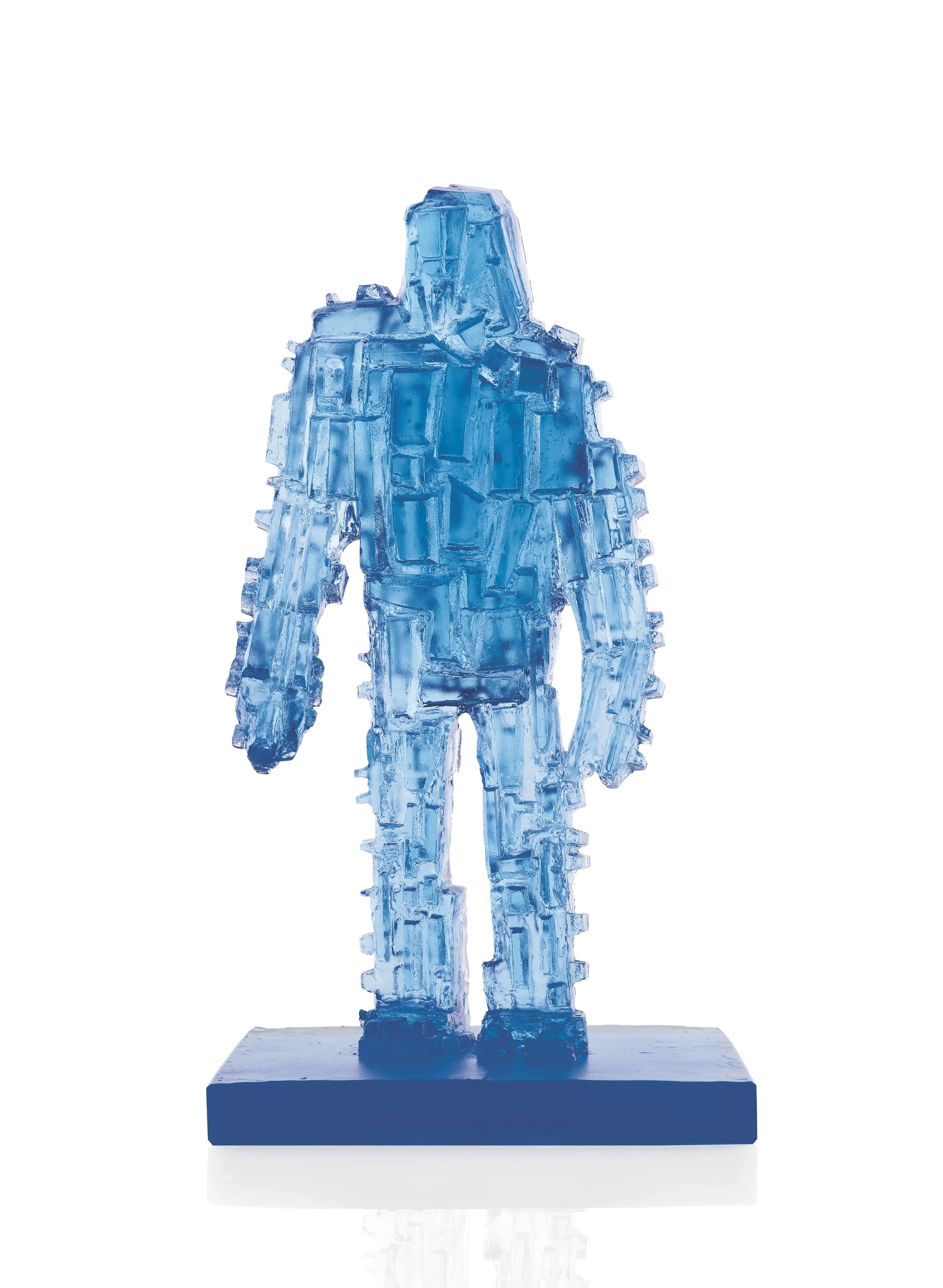
The sapphire blue statue of Flix illustrates the idea of the Campana brothers about ‘Outer Space Monsters’. “Our monsters are like aliens with a human shape inside. They are not ugly or terrifying. We see more horrible things in daily life,” says Fernando Campana.
You are extensively working with humble, upcycled materials such as bamboo, coconut fibers, pirarucu’s leather or wicker and putting them into new contexts or unusual combinations. Do you have some favorite materials?
Fernando: There are many materials I like! Something might draw my attention and I go for it, draw it and see it as a video. With pens, pencils and watercolors, I can see my creation being transformed into reality. Humberto follows more the production side, which he introduced me to. And I introduced him to the techniques, social and functional solutions. In other words, Humberto makes the cake and I put the cherry on top.
Humberto: For me it is very important to work with materials that do not cause too much damage to the environment. My main concern is to be politically correct, which is indeed difficult. I am very interested in working with natural fibers like bamboo and I am also working with terracotta. Every week I visit a place in Brotas where they make terracotta vases. I come and make tables, boxes and chairs instead. I have always been interested in clay but I had to mature to be able to achieve good results with something that is normally just used for vases. People there give me freedom and space to bring new ideas and techniques. It’s great fun!
What do you like the most about the Czech traditional techniques? I know you are big fans of glass!
Humberto: I like the Czech traditions very much. When I began as a designer in the 80s I was a big fan of Bořek Šípek, because of the fantastic way he uses glass. When I got an invitation to work with Lasvit, I felt very blessed to be part of this company with a great history that brings modernity to the traditional glass technique in the Czech Republic.
Fernando: We knew the glass that our grandparents brought from Europe, from Czechoslovakia and also from Murano. That was magical. So many layers and colors. It was so delicate. Our relationship with traditional craftsmen is also a social lesson: how they live, what their needs are and how they solve various issues. We can bring this to the masses or make something special. In a way, we make transits.
Your Candy collection which you designed for Lasvit five years ago is also full of colors. What was the main inspiration behind that?
Fernando: The inspiration comes from our childhood and visits to glass factories in Venice. We were also invited to see the production of Lasvit and suddenly it was possible to use a wide range of colors and transform our childhood images of candies and carnivals in Brazil. Our whole life is colorful, we cannot be black, white or red. It is an intersection of colors. Now in the summer, green is the most intense, bright and fluorescent color with spots of white, magenta, yellow. Looking at the city from my terrace, people are also colorful with different skin types and hair. There is an abundance of color that we follow in our objects. And having freedom of color was the best thing about working with Lasvit.
On the other, hand there is also the Fungo chandelier made for Lasvit, which is very minimalistic and simple. Based on the contrast of free and firm forms. A work inspired by natural processes of growing mushrooms on a piece of wood. Are you fascinated by these processes in your work?
Humberto: Things happened quite unexpectedly. At the beginning of my work for Lasvit, I was thinking about the sushi inspiration. Once it was finished, Maxim Velčovský invited me to visit the factory, where I saw a lot of old wood forms and suddenly there was a mushroom / fungi. So on the way to the airport I made a drawing which I sent to Maxim and asked about the possibility to create a chandelier and things began moving. Being there with people like Maxim and the factory employees gave me the inspiration to bring my best. I love that Fungo chandelier, for me it is one of the best pieces that I ever made. Firstly because it mixes two materials – wood and glass – and secondly for the way it happens. It was pure magic!
Your projects are frequently addressed to people who can afford affluence. What does it mean for you personally? In your view, how has the idea of “luxury” been changing over time?
Humberto: Luxury for me now is to think about the others. The pandemic showed everybody that we are all in the same boat. We need to be humble and help each other. Luxury today means collectivity and working with simple materials that do no harm to the planet. It is not about going to a luxury spa but about having experiences. For me it is much more about going to work with a community where I can bring new good vibes and not to be bored in Capri.
Fernando: Of course, a great part of the population is very rich. But we cannot forget the ones living in poverty. Whenever we do a workshop in a favela or for craftsmen we create a bridge and point them to different possibilities of creation. The contribution we make is showing them how to work with their potential. The product must have a price to simply express that it has a value. I don’t own a lot myself, but I can live very well with it. I feel comfortable here, having all the means to work and communicate with the world.
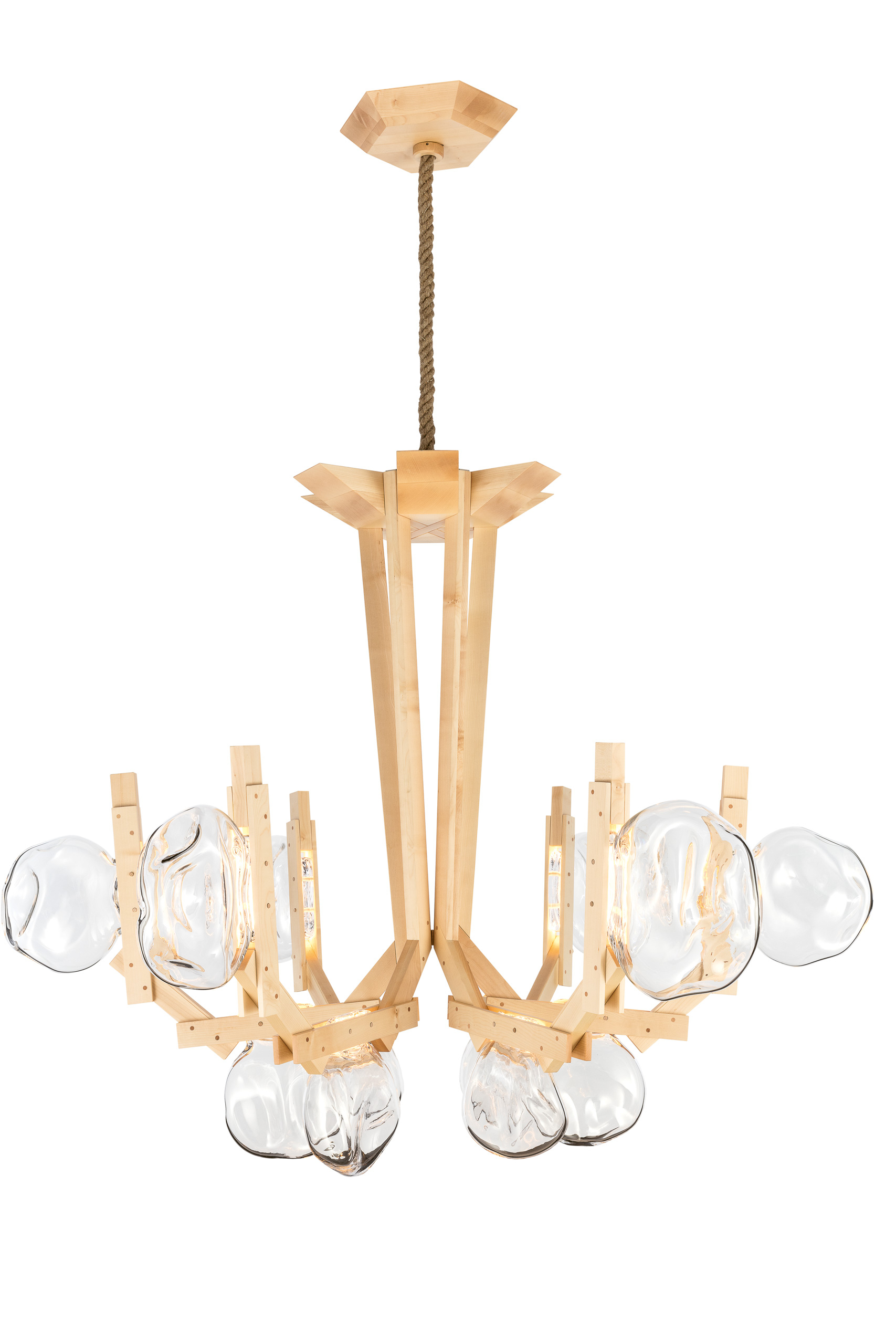
The Fungo chandelier was inspired by the fascinating shape of a mushroom growing on wood. The Campana brothers chose to blend the natural process with Lasvit’s glassmaking tradition. The result displays a striking contrast between the formal rigidity of the chandelier’s wooden structure and the blown-glass that appears to emerge spontaneously from the wood.
Over the last two years our spaces radically minimized traveling around the globe, meeting with the design community and changing contexts to more private ones. How did you deal with such a change? Do you already see the impacts of the pandemic reflected in your work?
Humberto: I want to do the same things that I always did – working with communities, promoting crafts to the level of design, rescuing traditions, going much more into the crafts process than the industrialized production. The world does not need a new chair. I think if you bring a new chair or an object, it needs to tell a personal history of where it comes from, whether it helped a community, for instance. Today it is vital to think about the planet, the circular economy, the materials, the process of appropriation etc. This pandemic is reminding us to slow down. We don’t need to get a jet to go to Italy to see a project, we can do it over Zoom or Skype. Slow everything down. That’s mentally healthy.
Can you tell us about your vision for the Instituto Campana, where you worked with people from handicrafts communities? How did the pandemic situation influence this aspect of your research?
Fernando: Because of the pandemic, we had to cut our visits to favelas in Sao Paolo for instance, the biggest “factory of crack”. It is not specifically for drug addicts, but we know that some members of the families there have such problems. This is a problem worldwide. It is important to have in mind what we can give them and what their possibilities are to adopt our ideas. We need to be careful and considerate in order to arrive at a very solid solution for those communities.
Humberto: Before the pandemic, the Instituto was doing very well working with different communities of the favelas – with favela kids we organized workshops, took them to movies, theatres, exhibitions… Today we are working only with one community in Piracicaba. The guys there produce fruit bowls made out of bricks thanks to a brick factory nearby. I go there and challenge them: see, bricks construct houses, so you can construct your own life working with this. We buy the bricks for them, sell the products in shops in Sao Paolo and give the money back to the community. I hope when this pandemic is over that we can start working again with the kids from the favelas and other communities. There is a plan to go to the Amazon to work with a community of weavers. This is all on standby right now.
What does privacy mean to you nowadays?
Fernando: There is my own mental and social privacy. It is also important to appear at social events to create connections, learn and contribute. But at the end of the day, I want to go home and stay in my garden and organize my personal life. Because if we do not organize ourselves, who is going to take care of this? We need to be more focused and centered.
Humberto: I have privacy whenever I have an idea in mind. I am very comfortable when I create, be it in the middle of a crowd or in a movie theatre. My mind stays in my own zone of comfort and nothing can disturb me, no bad energy can get inside. Hence privacy for me is to be creative, to have a good idea that safely maintains my equilibrium.
How do you see your work developing? Do you think you will keep creating new furniture, new design objects?
Humberto: I like design a lot because it makes me a human being. After 35 years with so many experiences in photography, fashion, gardening, design and art, I love to cross bridges and not get stuck in just one box – designer or artist. At the moment, for example, I am doing a project with curtains, in which I try to insert a poetic narrative. Also I am creating a botanical park where we mix art and design with biology. It will open next year in Brotas, my hometown, where I came into this world in order to give beauty and hope, show that people can change their lives.
Estudio Campana was founded in 1983 in Sao Paolo by brothers Fernando and Humberto Campana. It became famous for its furniture design and the creation of intriguing objects, such as the Vermelha and Favela chairs. From there, their portfolio has grown to include interior design, architecture, landscaping, scenography, fashion, artistic partnerships and more. The Campanas’ work incorporates the idea of transformation, reinvention and the integration of craftsmanship into mass production. Giving radiance to common materials, they show great creativity in their designs, but also stay in touch with their Brazilian roots – the colors, the combinations, the creative chaos, the triumph of simple solutions. Since 2016, they’ve been part of the Lasvit family, for which they’ve designed Candy and Fungus lighting collections and two sculptures of Outer Space Monsters.
